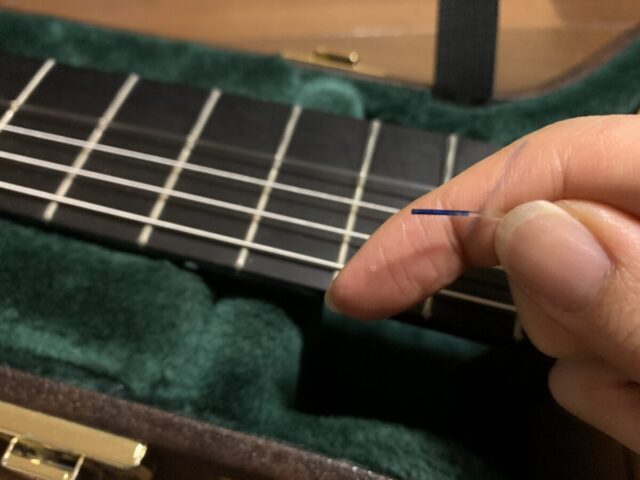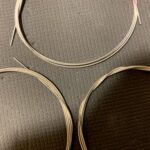Newly strung guitar strings are unstable in pitch. Many of us have experienced the sound of the strings dropping in pitch whether we play them or not. On the other hand, it is also true that the newer the strings, the better the sound, especially for bass strings. In this article, I will explain how to stabilize the pitch of newly strung guitar strings quickly.

The following article summarizes the classical guitar string-related articles on this site.
The pitch instability is due to the stretching of the strings.
The reason why the sound of newly strung guitar strings is unstable is because the strings keep growing. This is because the strings grow longer and longer.
A tensioned string will continue to stretch until it stabilizes. As it stretches, the tension drops, and the pitch drops.
This is inevitable. There is no classical guitar string that is stable in pitch the moment it is strung. This is inevitable.
For this reason, in order to play comfortably with a freshly strung string, you need to stabilize it as soon as possible.
How to stabilize your newly strung guitar strings as quickly as possible.
Now let’s take a look at how to stabilize your newly strung guitar strings as quickly as possible.
Just play it.
Guitar strings are tensioned as they are plucked.
This makes it possible to The more you play it, the faster you can stabilize it. The more you play, the faster you can stabilize.
You can practice and stretch out a song, or you can jangle and strum it like an electric or acoustic guitar.
Anyway Playing it to stabilize it is a simple and reliable way. The first thing to do is to
Use strings made of materials that are easy to stabilize.
Nylon, generally used for classical guitar strings, is a material that stretches very well and is difficult to stabilize.
Nowadays, there are many different materials that can be used for this purpose. If you use a string made of a material that stabilizes quickly, the pitch will settle more quickly. In recent years, there have been a number of alternatives to these materials.

We have reviewed over 70 different types of strings on our site. Please refer to this article for a summary.
Fluorocarbon (carbon) strings are faster for treble strings.
Carbon strings made of fluorocarbon are the most stable for treble strings. carbon strings made of fluorocarbon.
Carbon strings are available from a variety of manufacturers, including Savares Ariance and Pro Arte Carbon.
It used to be the norm for carbon strings to have a metallic, squeaky sound, but recently many carbon strings have been introduced that have less of a grating sound.
For more information about carbon, nylon, and titanium strings, please refer to this article.
Bass strings are quicker to use new materials for the core wire.
As for bass strings, it used to be the norm to use nylon as the core wire, but recently many new materials are being used for the core wire.
For example, Sabares’ Cantiga and Cantiga Premium, D’Addario’s Pro Arte Dynacore, and the list goes on and on.
Many of them are made of new materials, which stabilize pitch faster and have a longer life. If you choose such a material, it will stabilize faster than nylon ones.
For more information about the structure and types of bass strings, please refer to this article.
Using Stretcha
There is also an item to help stabilize the strings quickly. That is the Stretcha. is a stretcha.
By using a tool to pull, you can tension the string and stretch it faster.
See the following article for more details.
Don’t pull it with your fingers and force it to stretch.
If you want to stretch it with tension, why don’t you just use your fingers to pull it? You might think, but this is not recommended.
Finger stretching inevitably results in uneven string stretching, which can lead to poor string sound. If you use your fingers to stretch the strings, the strings will be stretched unevenly and the sound of the strings will be poor.
Also, according to the developers of Stretch, you need to keep stretching for at least 45 minutes to pull and stretch with your fingers. It doesn’t look good for your fingers. I’m not sure if this is true or not.
Strings are strung correctly.
The way the strings are strung is also important. If the strings are strung incorrectly, it will take longer for the strings to stabilize.
I especially like to wind as little as possible. The amount of string you wind on the string is directly related to stability. I feel that it is more stable if the amount of string wound on the string is as small as possible.
In order to reduce the amount of string wrapped around the string wind, it is recommended to pull the end of the string tightly.

For more information on stringing, please refer to this article.
Save the stabilized strings in advance.
If you want to change the strings right before the show, I recommend Have the strings stretched and stabilized beforehand. If you want to change the strings just before the performance, I recommend
Replace the strings with new ones and continue to pull until they are somewhat stable. As I mentioned in this article, it may take a few days for bass strings and a week for treble strings.
Then you remove the stable strings, store them, and reattach them before the show.
It also helps to sort out the treble strings, as some of them have poor pitch.
The caveat to this method is that if you prepare the strings too far in advance, the bass strings may rust and the sound may deteriorate. If you want to be on the safe side, it is best to keep them in a vacuum storage container.
Also, be careful not to cut off the excess when you install the strings, as is your usual habit.
Be careful not to stretch it too far or it will shorten your life span.
These methods will help stabilize the strings quickly, and you will be able to play a beautiful sound with stable pitch even if you change the strings before the show.
However, strings have a shortened life span and deteriorate with stability. If you try to stabilize them more than necessary, the sound may become worse and you may have to replace the strings sooner.
The only way to know how much is too much is to experience it, and the only way to know is through trial and error.
You can also refer to this article on when to change strings before a concert, recital, or performance.
To put it another way, when the sound of the string does not change at all, it can be said that it has reached the end of its life.
It can be said that the sound is good because the pitch is unstable, so it is important to get along with it.


















